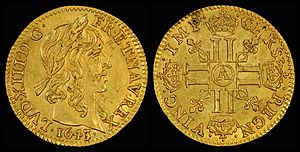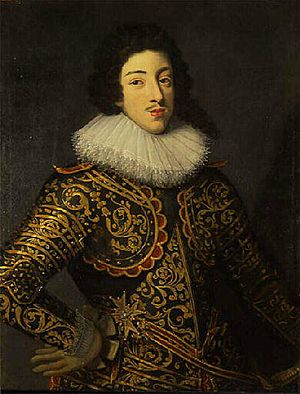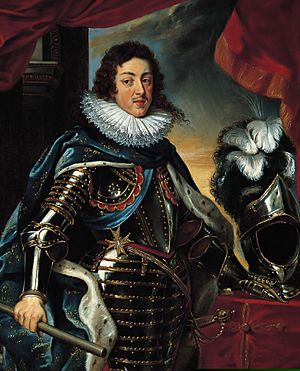Louis XIII facts for kids
Quick facts for kids Louis XIII |
|
|---|---|
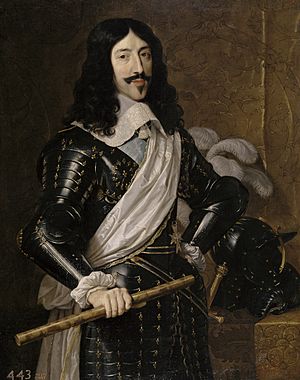
Portrait by Philippe de Champaigne, c. 1635
|
|
| King of France (more...) | |
| Reign | 14 May 1610 – 14 May 1643 |
| Coronation | 17 October 1610 Reims Cathedral |
| Predecessor | Henry IV |
| Successor | Louis XIV |
| Regent | Marie de' Medici (1610–1614) |
| Chief ministers |
See list
|
| King of Navarre (as Louis II) | |
| Reign | 14 May 1610 – 20 October 1620 |
| Predecessor | Henry III |
| Born | 27 September 1601 Château de Fontainebleau, Kingdom of France |
| Died | 14 May 1643 (aged 41) Saint-Germain-en-Laye, Kingdom of France |
| Burial | 19 May 1643 Basilica of St Denis, France |
| Spouse | |
| Issue | |
| House | Bourbon |
| Father | Henry IV of France |
| Mother | Marie de' Medici |
| Religion | Catholicism |
| Signature |  |
Louis XIII (born 27 September 1601 – died 14 May 1643) was the King of France from 1610 until his death. He was also the King of Navarre (as Louis II) from 1610 to 1620. In 1620, the crown of Navarre joined with the French crown. People sometimes called him the Just.
Louis became king of France and Navarre just before his ninth birthday. This happened after his father, Henry IV of France, was assassinated. His mother, Marie de' Medici, ruled the country for him as a Regent because he was too young.
Marie and her advisors made some mistakes in running the kingdom. There were also many political arguments. Because of this, the young king decided to take control in 1617. He sent his mother away and had her closest advisors arrested.
Louis XIII was a quiet and careful person. He relied a lot on his main advisors. First, it was Charles d'Albert, duc de Luynes, and then Cardinal Richelieu. Together, they are remembered for creating the Académie française. They also stopped rebellions by the French nobles. They made sure the king's power was strong. His rule also included fights against the Huguenots and Habsburg Spain.
Early Life of King Louis XIII
Louis XIII was born at the Palace of Fontainebleau. He was the oldest child of King Henry IV of France and his second wife, Marie de' Medici. As the king's son, he was called a "Son of France." As the oldest son, he was also the Dauphin of France, meaning he was next in line to the throne.
His father, Henry IV, was the first French king from the House of Bourbon. Louis XIII's grandparents were important figures in French and European history. As a child, he was cared for by the royal governess Françoise de Montglat.
An ambassador from England, Sir Edward Herbert, met Louis XIII in 1619. He noted that Louis had trouble speaking clearly. He would sometimes pause for a long time before he could say a word. Despite this, Louis was very active and loved hunting and hawking.
Marie de' Medici's Regency
Louis XIII became king in 1610 after his father was killed. His mother, Marie de' Medici, became the Regent. This meant she ruled the country until Louis was old enough. Louis officially became an adult at age thirteen in 1614. However, his mother continued to rule until 1617, when he was 16 years old.
Marie kept most of her husband's ministers. She mainly listened to Nicolas de Neufville, seigneur de Villeroy, Noël Brûlart de Sillery, and Pierre Jeannin. Marie tried to keep peace and confirmed the Edict of Nantes. This law gave rights to Protestants in France.
However, Marie could not stop nobles from rebelling. One noble, Henri, Prince of Condé (1588–1646), argued with Marie in 1614. He even gathered an army. Marie also raised her own army. She agreed to call an Estates General meeting to discuss Condé's complaints. This was a meeting of representatives from different parts of society.
The Estates General meeting was delayed until Louis XIII turned thirteen. Even though Louis was officially an adult, Marie remained the real ruler of France. The meeting did not achieve much. It mostly discussed France's relationship with the Pope and the sale of official jobs.
Starting in 1615, Marie began to rely more on Concino Concini. He was an Italian who became her favorite advisor. Many people disliked him because he was a foreigner. This made Condé even more angry, and he started another rebellion in 1616.
Leaders of the Huguenots (French Protestants) supported Condé's rebellion. This made Louis XIII think that they would never be loyal to him. Eventually, Condé and Queen Marie made peace with the Treaty of Loudun. This treaty gave Condé more power in the government. However, it did not remove Concini.
Later, in September, Marie and Louis imprisoned Condé. This was to protect Concini. This led to new revolts against the Queen and Concini. Louis XIII then decided to break away from his mother. He was encouraged by Charles d'Albert and other advisors. On 24 April 1617, Concini was killed during an attempt to arrest him. His wife was accused of witchcraft and executed. Marie was sent away to Blois. Louis then gave Charles d'Albert the title of Duke of Luynes.
Charles de Luynes's Power
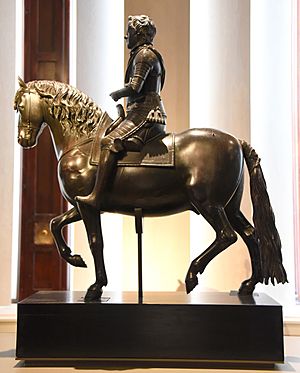
Luynes soon became as unpopular as Concini. Other nobles were unhappy that he had so much influence over the King. Many people thought Luynes was not as skilled as Henry IV's older ministers.
The Thirty Years' War began in 1618. At first, France was not sure which side to support. France had a long rivalry with the House of Habsburg, who were powerful rulers. This suggested France should help the Protestant countries. However, Louis XIII was a strict Catholic. He naturally wanted to support the Catholic Holy Roman Emperor, Ferdinand II.
The French nobles became even more upset with Luynes. This was because of changes to taxes and the sale of official jobs. Marie de' Medici, from her exile, became a symbol for those who were unhappy. The Bishop of Luçon, who later became Cardinal Richelieu, was allowed to advise Marie. He helped Marie and the King communicate.
French nobles started a rebellion on 2 July 1620. But the king's forces easily defeated them at the Battle of Ponts-de-Cé. Louis then went on a trip against the Huguenots in Béarn. They had ignored some royal decisions. This trip helped make Catholicism the official religion in Béarn again. However, this action caused Huguenots in other areas to rebel. This new rebellion was led by Henri, Duke of Rohan.
In 1621, Louis XIII officially made peace with his mother. Luynes was made Constable of France, a high military rank. Then, he and Louis went to stop the Huguenot rebellion. They tried to capture the Huguenot stronghold of Montauban. But they had to give up after three months. Many royal soldiers got sick and died. Luynes was one of the victims and died in December 1621.
Ruling with a Council
After Luynes died, Louis decided to rule with a council of advisors. His mother returned from exile and joined this council in 1622. In the council, Condé suggested using force against the Huguenots. However, the military campaign in 1622 was similar to the previous year. The king's forces won some early battles. But they could not capture the fortress of Montpellier.
The rebellion ended with the Treaty of Montpellier. Louis XIII and the Duke of Rohan signed it in October 1622. The treaty confirmed the rules of the Edict of Nantes. Some Huguenot fortresses were to be destroyed. But the Huguenots kept control of Montauban and La Rochelle.
Louis eventually fired Noël Brûlart de Sillery and Pierre Brûlart in 1624. He was unhappy with how they handled a diplomatic situation with Spain over the Valtellina region. Valtellina was important because it was a route to Italy for France. It also connected the Spanish and Holy Roman empires. Spain kept interfering in Valtellina, which angered Louis. He wanted to control this important passage.
Louis found a better advisor in his finance minister, Charles de La Vieuville. La Vieuville had similar views about Spain as the king. He advised Louis to side with the Dutch through the Treaty of Compiègne. However, La Vieuville was dismissed by mid-1624. This was partly because of his arrogant behavior. It was also due to a campaign by Cardinal Richelieu against him. Louis needed a new chief advisor, and Cardinal Richelieu became that person.
Cardinal Richelieu's Influence
Cardinal Richelieu played a very important role in Louis XIII's reign. From 1624, he guided France for the next eighteen years. Because of Richelieu's work, Louis XIII became one of the first examples of an absolute monarch. This means the king had complete power.
Under Louis and Richelieu, France successfully joined the Thirty Years' War against the Habsburgs. They kept the French nobles under control. They also took away the political and military rights of the Huguenots. However, they kept their religious freedoms. Louis XIII also successfully led the important Siege of La Rochelle.
In addition, Louis had the port of Le Havre updated. He also built a strong navy. Louis also worked to stop French artists from leaving for Italy to work. He hired painters like Nicolas Poussin and Philippe de Champaigne to decorate the Louvre Palace. In foreign matters, Louis helped develop New France. This expanded French settlements along the Saint Lawrence River from Quebec City to Montreal.
France Expands Overseas
Morocco
To continue the exploration started by his father, Louis XIII thought about creating a colony in Morocco. He sent a fleet led by Isaac de Razilly in 1619. Razilly explored the coast as far as Mogador. In 1624, he was sent to the pirate harbor of Salé in Morocco. His job was to deal with the issue of the Zaydani Library.
In 1630, Razilly was able to buy back French slaves from the Moroccans. He visited Morocco again in 1631. He helped negotiate the Franco-Moroccan Treaty (1631). This treaty gave France special treatment. This included lower tariffs, a French Consulate, and freedom of religion for French people.
Americas
Unlike other colonial powers, France, under Louis XIII and Cardinal Richelieu, wanted Natives and Colonists to live peacefully in New France.
Acadia also grew under Louis XIII. In 1632, Isaac de Razilly helped with the colonization of Acadia. He took control of the Habitation at Port-Royal (now Annapolis Royal, Nova Scotia). He developed it into a French colony. The King gave Razilly the title of lieutenant-general for New France. He took on military tasks. For example, he took control of Fort Pentagouet in Maine. He also told the English to leave all lands north of Pemaquid. This helped France get back its interests in Acadia.
In Brazil, the colony of Equinoctial France was started in 1612. However, it only lasted four years before the Portuguese ended it.
Asia
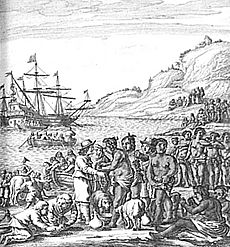
Relations between France and Japan began under Louis XIII in 1615. This was when Hasekura Tsunenaga, a Japanese samurai and ambassador, visited Saint-Tropez. He was on his way to Rome. In 1636, Guillaume Courtet, a French priest, visited Japan.
Also in 1615, Marie de' Medici helped merchants from Dieppe start the Company of the Moluccas. In 1619, an armed group of three ships was sent from Honfleur. This "Fleet of Montmorency" was led by General Augustin de Beaulieu. Its goal was to fight the Dutch in the Far East. In 1624, Cardinal Richelieu reached an agreement with the Treaty of Compiègne. This stopped the fighting between the Dutch and French in the Far East.
Louis XIII and His Brother
Louis XIII's younger brother, Gaston, Duke of Orléans, often plotted against the king's government. He tried to weaken the power of his mother and Cardinal Richelieu. Because of this, Gaston had to leave France twice. After fighting an unsuccessful war, he found safety in Flanders. In 1643, when Louis XIII died, Gaston became Lieutenant-General of the kingdom. He then fought against Spain on France's northern borders.
Marriage and Family
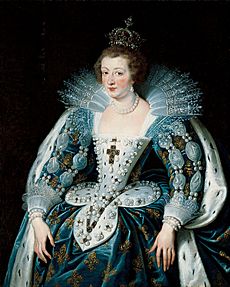
On 24 November 1615, Louis XIII married Anne of Austria. She was the daughter of Philip III of Spain. They were second cousins. This marriage continued a tradition of using royal weddings to strengthen alliances between Catholic countries like France and Spain.
Their marriage was only happy for a short time. The king's duties often kept them apart. After many years of marriage, Anne finally gave birth to a son on 5 September 1638. This son would become Louis XIV.
Many people saw this birth as a miracle. In thanks, his parents named him Louis-Dieudonné, which means "God-given." As another sign of gratitude, Louis XIII dedicated France to the Virgin Mary seven months before his son's birth. The queen also founded the Benedictine abbey of the Val-de-Grâce. Louis XIV later laid the first stone for its church, a beautiful example of French Baroque architecture.
The couple had two sons:
| Name | Portrait | Lifespan | Notes |
|---|---|---|---|
| Louis-Dieudonné, Dauphin of France (later Louis XIV) | 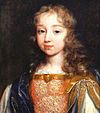 |
5 Sep 1638 – 1 Sep 1715 | Married Maria Theresa of Spain (1638–83) in 1660. Had children. |
| Philippe of France, Duke of Anjou (later Duke of Orléans) | 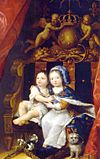 |
21 Sep 1640 – 8 Jun 1701 | married (1) Princess Henrietta of England (1644–70) in 1661. Had children. Married (2) Elisabeth Charlotte of the Palatinate (1652–1722) in 1671. Had children. |
A writer named Voltaire claimed that Louis XIII had another son who was kept in prison. This son's face was supposedly hidden behind an iron mask. This is a famous story, but it is a fictional claim.
Death of Louis XIII
Louis XIII was not well during the winter of 1642–1643. He managed to go on a few hunting trips. But by mid-February, he was mostly in bed. Based on descriptions from that time, historians believe he had a serious illness. On 13 April, his main doctor told him that his illness would be fatal. He died in Paris on 14 May 1643. This was exactly 33 years after his father's death.
King Louis XIII as a Musician
Louis XIII loved the lute, just like his mother. He had a lute as one of his first toys. His personal doctor reported that Louis played it for his mother when he was just three years old. In 1635, Louis XIII created a ballet called "Ballet de la Merlaison." He composed the music, wrote the story, and designed the costumes. The king himself danced in two performances of the ballet that same year.
Louis XIII's Influence on Fashion
Louis XIII also influenced men's fashion. In 1624, he helped make it popular for men to wear wigs. This fashion spread across Europe. It was a popular style for men for about 140 years. It only changed after the French Revolution in the 1790s.
Louis XIII in Stories and Movies
- Louis XIII, his wife Anne, and Cardinal Richelieu are important characters in Alexandre Dumas, père's 1844 novel The Three Musketeers. They also appear in many movies and TV shows based on the book. The book shows Louis as a king who lets Richelieu be powerful but knows about his plans. He is often shown as bored and serious, less clever than Richelieu.
- Movies like the 1948, 1973, or 2011 versions often show Louis XIII as a funny character. He is sometimes shown as clumsy and not very good at ruling. In the 1993 film, he is shown as someone who can stand up to Richelieu when needed. But he is still greatly influenced by him. He is also shown as loving his wife, Anne, but being very nervous around her.
- The 2014 BBC TV series, The Musketeers, mixes history with fiction. It shows the King as both not very good at ruling and strong. His alliance with Spain is always changing. Ryan Gage plays him in this series.
- Arthur Lubin played Louis XIII in the 1926 film Bardelys the Magnificent.
- Louis XIII, his wife Anne, his younger brother Gaston, Cardinal Richelieu, and Cardinal Mazarin are mentioned in the 1632 series of novels by Eric Flint and others. This is especially true in 1636: The Cardinal Virtues.
- Louis XIII appears in novels from Robert Merle's Fortune de France series (1977–2003).
- Louis XIII was played by Edward Arnold in the 1935 film Cardinal Richelieu. George Arliss played the Cardinal.
- Ken Russell directed the 1971 film The Devils. Louis XIII is a main character in this movie. However, his portrayal in the film does not match the real historical figure. The film was based on Aldous Huxley's 1952 book The Devils of Loudun.
- Louis XIII appears in the 2002 Doctor Who audio drama The Church and the Crown.
Images for kids
See also
 In Spanish: Luis XIII de Francia para niños
In Spanish: Luis XIII de Francia para niños
- Absolute monarchy in France
- Charles de Lorme, personal medical doctor to Louis XIII
- French monarchs family tree



